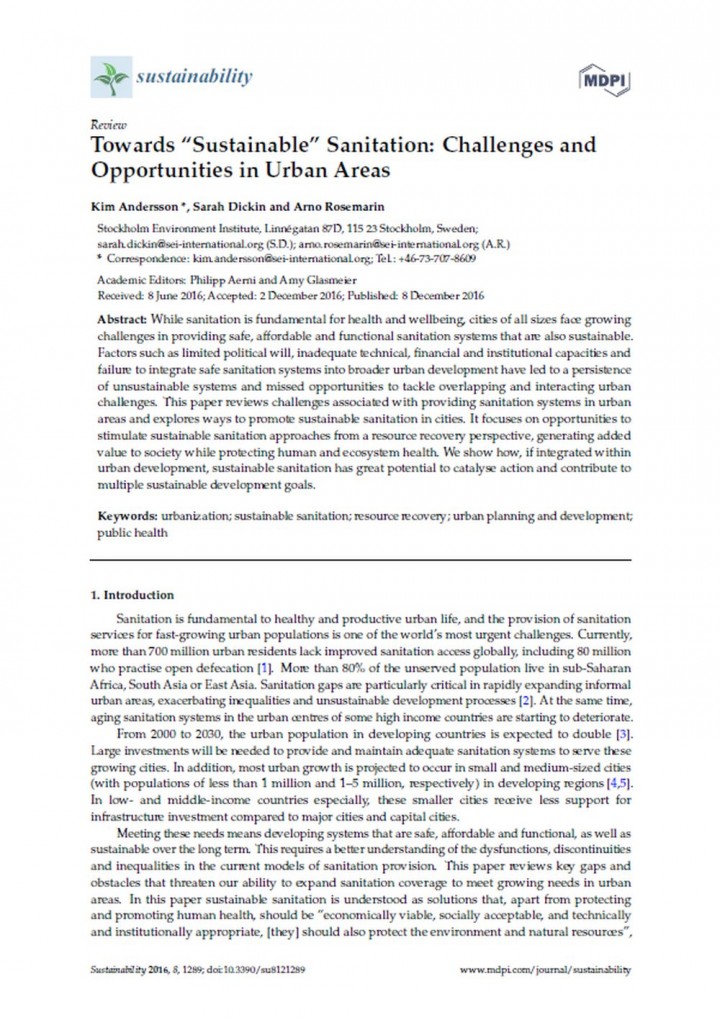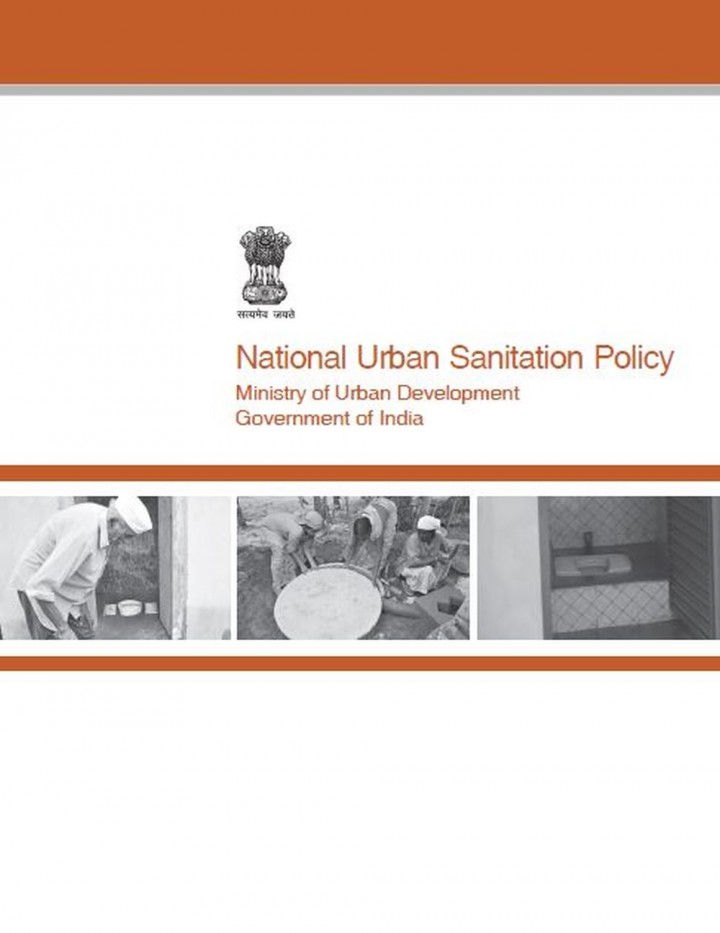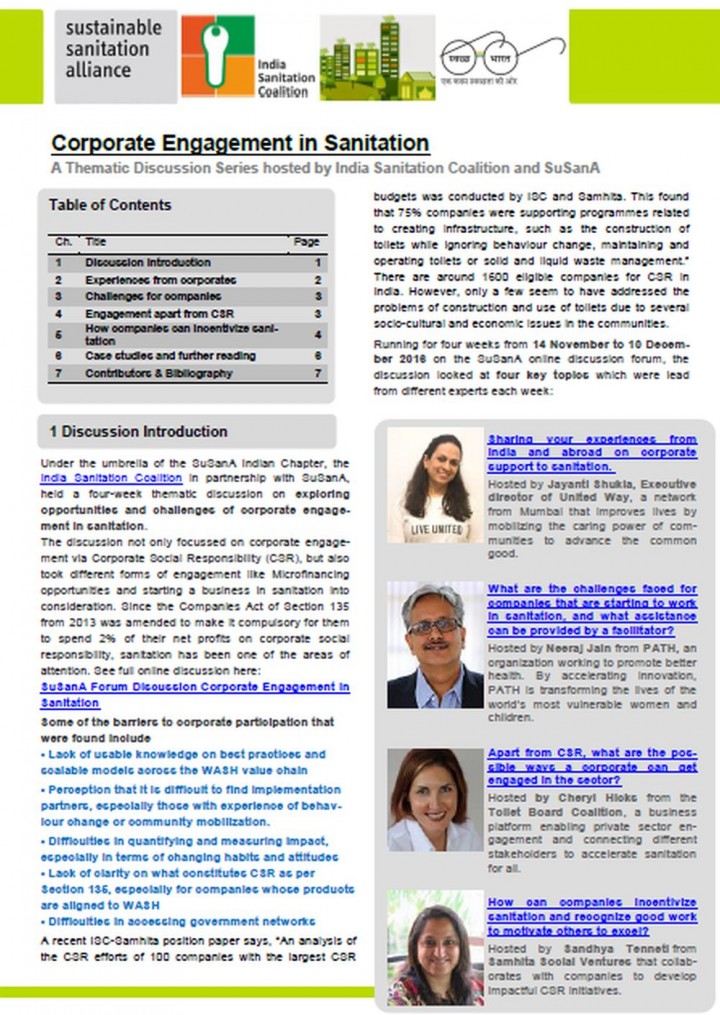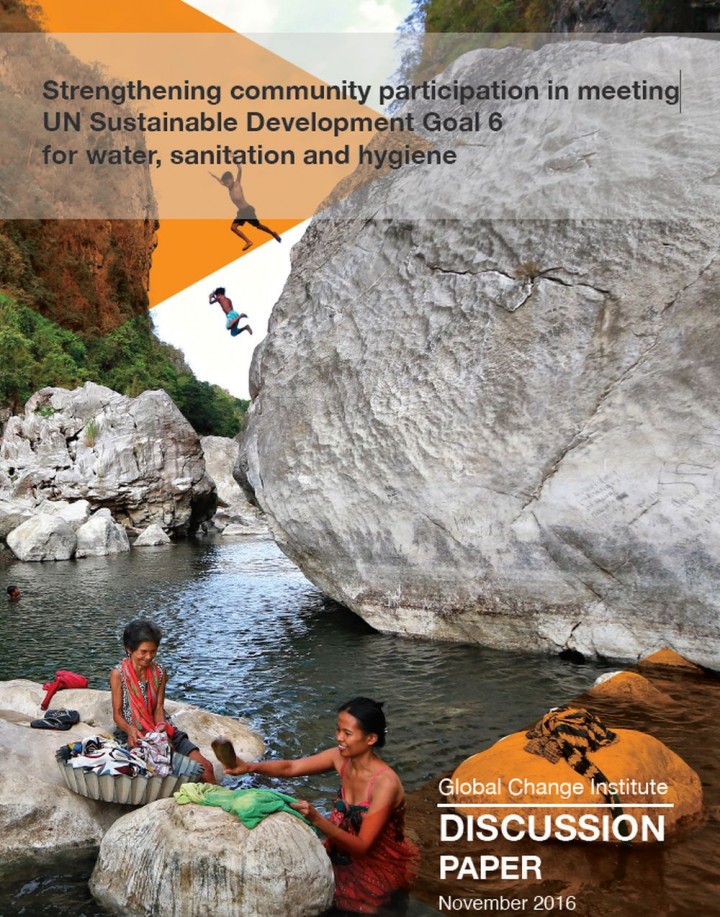Andersson, K., Dickin, S., Rosemarin, A. (2016) Towards “Sustainable” Sanitation: Challenges and Opportunities in Urban Areas
While sanitation is fundamental for health and wellbeing, cities of all sizes face growing challenges in providing safe, affordable and functional sanitation systems that are also sustainable. Factors such as limited political will, inadequate technical, financial and institutional capacities and failure to integrate safe sanitation systems into broader urban development have led to a persistence of unsustainable systems and missed opportunities to tackle overlapping and […]
Parkinson, J., Lüthi, C., Walther, D. (2014) Sanitation 21 A Planning Framework for Improving City-wide Sanitation Services
Sanitation21 is an important component of the global sanitation toolkit, which presents a planning framework based on international best practices. Initially developed in 2006, this updated version builds on recent experiences where good planning has formed an integral part of achieving improvements in urban sanitation. In the context of this document, planning is essentially about responding to real needs and making informed decisions about investments for […]
Ministry of Urban Development (Government of India) (2014) National Urban Sanitation Policy
This publication summarizes the background, vision and sanitation policy issues in India that are adressed with the National Urban Sanitation Policy by the Ministry of Urban Development. It also provides draft frameworks, e.g. for City Sanitation Plans or developing state sanitation strategies.
Walther, D. et al. (2014) Support to the National Urban Sanitation Policy (SNUSP II) Factsheet
This factsheet provides an overview of the SNUSP Project objectives, approach and achievements.
Jacob, N., von Falkenhausen, A., Bauer, M. (2017) Corporate Engagement in Sanitation Synthesis Document - SuSanA Indian Chapter online discussion
Under the umbrella of the SuSanA Indian Chapter, the India Sanitation Coalition in partnership with SuSanA, held a four-week thematic discussion on exploring opportunities and challenges of corporate engagement in sanitation. This synthesis is a summary of all topics discussed in the forum about corporate engagement. The discussion not only focussed on corporate engage-ment via Corporate Social Responsibility (CSR), but also took different forms of […]
Walther, D. et al. (2015) Introducing City Sanitation Plan - SNUSP II Trainer's Manual
Ensuring citywide sanitation is challenging and needs strategic planning as well as involvement of various actors /agencies, such as decision makers at state and city level, city engineers and technical experts in areas of urban planning, sanitation, technical infrastructure and financing. One of the main requirements in establishing a citywide sanitation system on the ground is strong institutions and technical as well as managerial capacities […]
Walther, D. et al. (2016) Preparing City Sanitation Plan - SNUSP II Trainer's Manual
This training programme is a unique blend of training courses for participants coupled with additional handholding support through various mechanisms in a step-wise manner. This is a distinguishing feature from other stand-alone training programmes and ensures that the participants are themselves capacitated through the training. Handholding support leads to transfer of knowledge on the ground for achieving actual change in their respective cities. This training […]
Nandan, V., Dua, S. (2014) Enabling Systems for Improved Municipal Solid Waste Management in Cities Making way for a clean and healthy India
This factsheet was published by the Support to National Urban Sanitation Policy-Project by GIZ India to give an overview of ways that this project apporaches to manage Municipal Solid Waste (MSW) in urban areas.
Hall, N. et al. (2016) Strengthening community participation in meeting UN Sustainable Development Goal 6 for water, sanitation and hygiene Discussion Paper No.3
Countries have much work to do to achieve the UN Sustainable Development Goals by 2030. But development projects don’t always go the way you expect. A resettlement project in Laos recently provided taps and toilets as a way to improve hygiene and health outcomes for communities. But on revisiting the resettled village, the project team was dismayed to find that the new brick toilet facilities […]
Hall, N. et al. (2016) Achieving the UN Sustainable Developement Goals for water and beyond Discussion Paper No.2
This transdisciplinary discussion paper, from 13 researchers across seven schools at The University of Queensland, considers Australia’s efforts to achieve the United Nations Sustainable Development Goals in Australia and within the broader Asia-Pacific region. It focuses particularly on those SDGs that are concerned with water, and it challenges the current steps being undertaken towards attaining the SDGs in both Australia and overseas. The recommendations identify […]
Hall, N. et al. (2016) The UN Sustainable Development Goals for water and sanitation - How should Australia respond within and beyond its borders? Discussion Paper No.1
Australia is positioned next to south-east Asia, where one billion people lack access to adequate sanitation facilities. Only half the population in the Pacific Island countries have access to such facilities, while poor hygiene and unsanitary living conditions have contributed to children in remote Australian Aboriginal communities experiencing a higher rate of common infectious diseases than in large urban communities. In 2015, the UN updated […]
Stockholm International Water Institute (2016) City-wide sanitation: The role of planning Policy brief
In 2016 the World Water Week (WWW) brought together leading experts from around the world to discuss and share the latest experiences on planning urban sanitation in two sessions convened by WaterAid, UNDP-SIWI Water Governance Facility, GIZ, SuSanA, and the World Bank. This policy brief synthesises the key lessons and recommendations that grew out of that encounter, calling for more flexible and context-sensitive planning and […]
De Albuquerque, C. (2014) Realising the human rights to water and sanitation: A handbook Arabic, French, Portuguese and Spanish
A product of six years of work, the goal of the handbook is to explain the meaning and legal obligations of these rights and to translate complex technical and legal language into accessible information. Designed for a broad audiences in the Global South and North, the information should be useful to civil society sanitation advocates, human right organizations, national and local offcials, service providers, and […]
SuSanA (2016) SuSanA - Thematic Discussion Series synthesis template
This is the template for SuSanA Thematic Discussion Series syntheses in a Word format. Please use this format if you wish to prepare a new SuSanA synthesis. If you have any questions please E-Mail the secretariat: info@susana.org
Monse, B. et al. (2016) Localized school-based feeding concept in the autonomous region of Muslim
Making schools healthy environments requires a holistic approach that should combine various interventions to ensure that children are fit for school. However, these interventions must be simple, scalable, sustainable, and integrated into existing systems to ensure that they can be feasibly implemented by school communities with limited resources. Increasing its usefulness could only be possible if they could easily blend with accepted practices and ensuing […]
Toilet Board Coalition Secretariat (2016) The digitalisation of sanitation Transformation to smart, scalable and aspirational sanitation for all
In 2016 the Toilet Board Coalition ran a Feasibility Study to explore the potential role of mobile and digital applications to drive efficiencies and consumer demand in sanitation business models operating in low income markets. The following questions were at the centre of our inquiry: • How are sanitation businesses operating in low-income markets using mobile and digital applications in their businesses today? • How are sanitation […]
GTO (2016) WASH ePaper Issue No.6 (in English, French and Spanish)
The WASH ePaper is an online magazine published at regular intervals in German, English, French and Spanish. Each issue takes a closer look at a current key issue in the water, sanitation and hygiene (WASH) sector and related areas. It also provides updates on forthcoming national and international events, highlights current publications and projects, and reports on news from the sector. The WASH e-paper is […]
Fernández-Martínes, L. (2016) Using the Shit/Excreta Flow Diagrams (SFDs) for modelling future scenarios in Kumasi, Ghana A research project submitted in partial fulfilment of the requirements for the award of the degree of Master of Science of Loughborough University
The high population density of the cities does not allow families to safely abandon onsite sanitation facilities. This creates a need for a sanitation service chain to safely manage feacal waste. Hence, Shit/Excreta Flow Diagrams (SFD) are being developed as an analysis tool, which illustrates excreta pathways along the sanitation service chain in a city. The main objective of this study is to use the […]
Hague, J. (2016) Sanitation in the circular economy Transformation to a commercially valuable, self-sustaining, biological system
In 2016 the Toilet Board Coalition ran a feasibility study to explore the potential role of sanitation in the circular economy. The following questions were at the centre of our inquiry: • Are there products or materials of value being upcycled from toilet resources? • Are there scalable business models to deliver sustainable supply of these products to the market? • Is there commercial interest and demand from […]
Hynes, P. (2016) Thematic Discussion: Integrating sectors to address the holistic needs of children Thematic Discussion Series Synthesis
The new era of the Sustainable Development Goals (SDGs) has enhanced the conversation around the need for partnerships (SDG 17) and has accelerated a conversation about how organisations should best work together. The success of each SDG is linked to the progress of all the other Goals, especially when we consider the most vulnerable, such as children in their first 1,000 days of life. A […]




















